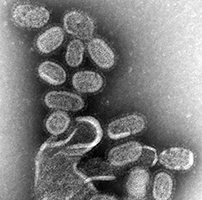Respiratory pathogens in patients with acute exacerbation of non-cystic fibrosis bronchiectasis from a developing country

Submitted: January 18, 2021
Accepted: April 14, 2021
Published: April 22, 2021
Accepted: April 14, 2021
Abstract Views: 1418
PDF: 831
Publisher's note
All claims expressed in this article are solely those of the authors and do not necessarily represent those of their affiliated organizations, or those of the publisher, the editors and the reviewers. Any product that may be evaluated in this article or claim that may be made by its manufacturer is not guaranteed or endorsed by the publisher.
All claims expressed in this article are solely those of the authors and do not necessarily represent those of their affiliated organizations, or those of the publisher, the editors and the reviewers. Any product that may be evaluated in this article or claim that may be made by its manufacturer is not guaranteed or endorsed by the publisher.
Similar Articles
- A.J. Lopes, T.T. Mafort, A. de Sá Ferreira, M.C. Santos de Castro, M. de Cássia Firmida, E. de Andrade Marques, Is the type of chronic pulmonary infection a determinant of lung function outcomes in adult patients with cystic fibrosis? , Monaldi Archives for Chest Disease: Vol. 77 No. 3-4 (2012): Pulmonary series
- R.W. Dal Negro, C. Micheletto, S. Tognella, Use of aerosols in bronchiectasis patients , Monaldi Archives for Chest Disease: Vol. 75 No. 3 (2011): Pulmonary series
- Seyed Hamid Borsi, Homeira Rashidi, Maryam Shaabanpour, Hanieh Raji, The effects of inhaled corticosteroid on insulin sensitivity in asthmatic patients , Monaldi Archives for Chest Disease: Vol. 88 No. 1 (2018)
- Zain Ahmad Khan, Akbar Shoukat Ali, Imran Ahmed, Joveria Farooqi, Muhammad Irfan, Frequency of viral etiology in community-acquired pneumonia , Monaldi Archives for Chest Disease: Early Access
- J.P. Zellweger, Tobacco and tuberculosis , Monaldi Archives for Chest Disease: Vol. 69 No. 2 (2008): Pulmonary series
- Rupak Singla, Amitesh Gupta, Vikas Kumar, Chandrasekaran Padmapriyadarsini, Devika Tayal, Shweta Anand, Abhishek Faye, AK Hemanth Kumar, Madhumita Paul Choudhary, Study of risk factors and clinical management of patients with clinical non-response due to low plasma levels of anti-tubercular drugs , Monaldi Archives for Chest Disease: Early Access
- Princy Domnic Dsouza, Sai Phalguna Prakash Chitralu, Chandrashekhar Mallikarjun Patil, Vinod Ashok Koujalagi, Sanatkumar Bharamu Nyamagoud, Prescription patterns and drug utilization in respiratory tract infections: implications for antimicrobial stewardship at a tertiary care teaching hospital , Monaldi Archives for Chest Disease: Early Access
- Shayan Shahid, Ali bin Abdul Jabbar, Abdullah Wagley, Muhammad Daniyal Musharraf, Haris Zahid, Syed Muhammad Zubair, Muhammad Irfan, Non-cystic fibrosis bronchiectasis: a retrospective review of clinical, radiological, microbiological and lung function profile at a tertiary care center of a low-middle-income country , Monaldi Archives for Chest Disease: Vol. 94 No. 3 (2024)
- Aladdin Bashir, Matthew Holmes, Nebumathew Suresh, Pedram Panahi, Sameh Atta, Hannah T. Perkins, Clinton Lloyd, Sanjay Asopa, The impact of COVID-19 prevention measures on surgical wound infection rates post-cardiac surgery , Monaldi Archives for Chest Disease: Vol. 94 No. 2 (2024)
- M. Gharagozlou, F.A. Ebrahimi, A. Farhoudi, A. Aghamohammadi, M.-H. Bemanian, Z. Chavoshzadeh, M. Heidarzadeh, M. Mehdizadeh, M. Moin, M. Movahedi, M. Nabavi, Z. Pourpak, N. Rezaei, Pulmonary complications in primary hypogammaglobulinemia: a survey by high resolution CT scan , Monaldi Archives for Chest Disease: Vol. 65 No. 2 (2006): Pulmonary series
You may also start an advanced similarity search for this article.

 https://doi.org/10.4081/monaldi.2021.1771
https://doi.org/10.4081/monaldi.2021.1771





